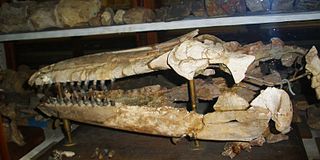
The cetacean family Monodontidae comprises two living whale species, the narwhal and the beluga whale and at least four extinct species, known from the fossil record. Beluga and Narwhal are native to coastal regions and pack ice around the Arctic Ocean. Both species are relatively small whales, between three and five metres in length, with a forehead melon, and a short or absent snout. They do not have a true dorsal fin, but do have a narrow ridge running along the back, which is much more pronounced in the narwhal. They are highly vocal animals, communicating with a wide range of sounds. Like other whales, they also use echolocation to navigate. Belugas can be found in the far north of the Atlantic and Pacific Oceans; the distribution of narwhals is restricted to the Arctic and Atlantic Oceans.

Orcinus is a genus of Delphinidae, the family of carnivorous marine mammals known as dolphins. It includes the largest delphinid species, Orcinus orca, known as the orca or killer whale. Two extinct species are recognised, Orcinus paleorca and O. citoniensis, describing fossilised remains of the genus. The other extinct species O. meyeri is disputed.

Squalodon is an extinct genus of whales of the Oligocene and Miocene epochs, belonging to the family Squalodontidae. Named by Jean-Pierre Sylvestre de Grateloup in 1840, it was originally believed to be an iguanodontid dinosaur but has since been reclassified. The name Squalodon comes from Squalus, a genus of shark. As a result, its name means "shark tooth". Its closest modern relative is the South Asian river dolphin.

Parapontoporia is an extinct genus of dolphin that lived off the Californian coast from the Late Miocene until the genus' extinction during the Pliocene. It is related to the baiji.

Australodelphis mirus is an extinct Pliocene dolphin. A. mirus is known from fossils found in the Sørsdal Formation, Mule Peninsula, Vestfold Hills, East Antarctica. The genus has been described as an example of convergent evolution with beaked whales.

Kentriodontidae is an extinct family of odontocete whales related to modern dolphins. The Kentriodontidae lived from the Oligocene to the Pliocene before going extinct.

Euthecodon is an extinct genus of long-snouted crocodile. It was common throughout much of Africa during the Neogene, with fossils being especially common in Kenya, Ethiopia, and Libya. Although superficially resembling that of gharials, the long snout was a trait developed independently from that of other crocodilians and suggests a diet of primarily fish. Euthecodon coexisted with a wide range of other crocodiles in the areas it inhabited before eventually going extinct during the Pleistocene.

Plesiobalaenoptera is a genus of extinct rorqual which existed in Italy during the late Miocene epoch. The type species is P. quarantellii. It is the oldest known rorqual from the Mediterranean basin. Fossils have been found from sediments of the Stirone River in northern Italy that were deposited during the Tortonian age, around 11 to 7 million years ago.

The blunt-snouted dolphin is a prehistoric pilot whale known from a single specimen, consisting of a partial rostrum, partial maxilla, partial premaxilla, and partial vomer. The fossil was discovered by Albert Hoekman on board a fishing trawler in the North Sea in 2008 and described in 2010 by Klaas Post and Erwin J.O. Kompanje. The blunt-snouted dolphin is believed to have had a balloonlike structure atop its rostrum and is estimated to have lived during the middle Pliocene to early Pleistocene.

Orcinus citoniensis is an extinct species of killer whale identified in the Late Pliocene of Italy and the Early Pleistocene of England. It was smaller than the modern killer whale, 4 m (13 ft) versus 7 to 10 m, and had around 8 more teeth in its jaw. It may have resembled the modern killer whale in appearance, and could represent a transitional species between the modern killer whale and other dolphins. O. citoniensis could have hunted fish and squid in pods, and coexisted with other large predators of the time such as the orcinine Hemisyntrachelus and the extinct shark Otodus megalodon.

Hemisyntrachelus is an extinct genus of cetacean.
Auroracetus, from Aurora and the Latin cetus (whale), is a genus of Pontoporiidae, the river dolphins, and contains one extinct species. The species Auroracetus bakerae was published in 2009.
Huaridelphis is an extinct genus of river dolphins from the Early Miocene. The type species is H. raimondii, found in the Chilcatay Formation of the Pisco Basin.
Zarhinocetus is an extinct genus of whale from the Early to Middle Miocene of the eastern North Pacific.
Allodelphinidae is a family of primitive platanistoid river dolphins found in marine deposits in the eastern North Pacific region, Alaska, and Japan.

Lophocetus is an extinct genus of dolphin belonging to the clade Delphinida that is known from late Miocene (Tortonian) marine deposits in California and Maryland. Although usually placed in Kentriodontidae, recent studies have found it only distantly related to Kentriodon.

Brachydelphis is a genus of pontoporiid known from the Late Miocene Pisco Formation of Peru and the Bahía Inglesa Formation of Chile.
Eodelphinus is an extinct genus of oceanic dolphins belonging to the family Delphinidae.
Pachyacanthus is an extinct genus of toothed whale that lived about 15.97 to 2.589 million years ago. It contains the single species Pachyacanthus suessi. The genus is known from European deposits in Hungary, Kazakhstan, Austria and Italy. The type specimen consisted of a few fragments of a rostrum and two fragmentary tympanic bullae. Skeletons from the Sarmatian of Austria did not include skulls.














